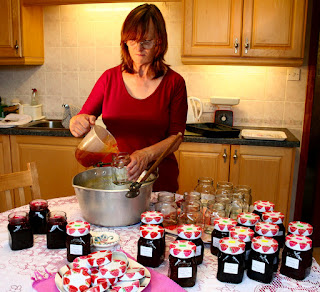PRESERVE THE SUMMER FRUITS
Back in the mists of time, all the local kids went berry picking in summer as farmers grew raspberries and strawberries outdoors. We always brought back whatever spare fruit we could carry, so mother could make some jam. This delicious product was food, so it went on your piece quite thick. Although it was very high in sugar, we were very active outdoor kids surrounded with woods to explore and the Sidlaw Hills, only just over one hour’s walk away, so you soon burned off any additional calories. However, life moves on and everything changes. Computers are now many kids pastime of choice, outdoor activities are limited by weather, health and safety, availability of cars for travel, and now we can all afford cakes and biscuits, so bread and jam is no longer a staple food. We are also a wealthier nation so very few locals go berry picking, leaving the harvest, now under tunnels, to East European immigrants.
Home made jam is now a special treat brought out to impress and delight guests with tastes and flavours of summer. As kids we just enjoyed the taste of fresh berries picked from the bush and eaten immediately. We had no idea that these were packed with vitamins, minerals and antioxidants and would ensure good health. Today there is such a wide variety of fruit available to grow that you can eat a very healthy diet of fresh fruit from the first strawberries at the end of May till the last greenhouse grapes in December, all from your own garden.
Harvesting the soft fruit
Early strawberries were a disaster as botrytis rotted most of the fruit, but Rhapsody and Symphony being a bit later in fruiting missed the worst of the rain, so I got nearly 50% of the crop.
My summer raspberries are only recently planted, but the crop is being swamped by very vigorous growth from new canes. Autumn Bliss is very late so only time will tell if we get a crop this year.
Red currants, blackcurrants, saskatoons, blueberries and gooseberries are all giving huge crops, and if we get a late summer my figs will produce a bumper crop as it is really loaded with good sized figs. Bramble Helen has started to crop and looks excellent and my outdoor cherry Cherokee has a small but very tasty crop of cherries. The dwarf cherry trees are well netted from birds.
Using and preserving berries
 Although we eat our berries fresh throughout the summer at breakfast, lunch and supper time almost every day, and consume a fair bit while picking them, there is always ample left over for freezing and preserves. We can eat all our cherries and figs as they ripen, but most other fruit get preserved as jam, compotes, summer puddings, muffins or fermented to stock up my wine cellar.
Although we eat our berries fresh throughout the summer at breakfast, lunch and supper time almost every day, and consume a fair bit while picking them, there is always ample left over for freezing and preserves. We can eat all our cherries and figs as they ripen, but most other fruit get preserved as jam, compotes, summer puddings, muffins or fermented to stock up my wine cellar.Summer is jam making time. In my youth before freezers were invented, I would make about 100 jars of jam and store them in a cool place over winter. I could easily eat 2lbs of jam a week.
However, today, jam is now made with fruit from the freezer as required, and I eat a bit less.
Anna has been busy making some blackcurrant, saskatoon and strawberry jam as well as apricot from dried fruit, and a particularly good mix of rhubarb, fig and prune.
As the crops come in and our four freezers fill up, I will have to start my wine making season to make room in the freezers for more berries. This will be the first year I will make gooseberry wine, but we have had very heavy crops, so nothing gets wasted. Gooseberries are also brilliant when slightly stewed and sweetened and used in muesli at breakfast or in Greek yoghurt and a spoonful of honey for lunch.
All of the summer berries make excellent compote used all year round and summer puddings. Compote is invaluable with muesli, yoghurt and puddings.
Our blackcurrant crop is so heavy that we will be trying some as a health drink high in vitamin C and antioxidants. This can be stored in plastic bottles in the freezer. We are also looking forward to trying the blackcurrant Liqueur De Cassis, which hopefully will be ready for Christmas.
Plant of the week
Tuberous Begonias are extremely reliable, and even in these wet sunless summers they still cover themselves in masses of bright flowers. They are perfect for mass planting in beds or individually as specimens in a large tub. Give them good soil, a wee bit fertiliser and don’t let them dry out in a normal summer. Tubers are not cheap, but they last a lifetime and will slowly multiply, as they can be divided in spring, (cut the tuber with a sharp knife) once you can see where the young shoots are.
Painting of the month
Summer Roses is a figure study in oil on canvas painted for my exhibition at Dundee Botanical Gardens at the beginning of October when I will be showing images of the Artist’s model. Although I paint flowers, landscapes and snow scenes, it is figurative painting that gives the greatest challenge, as there is little scope for error trying to combine the beauty of the female form as well as creating an attractive painting using colour, form, tone and line.
END


















